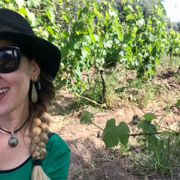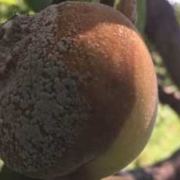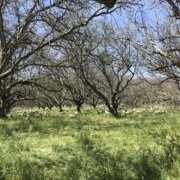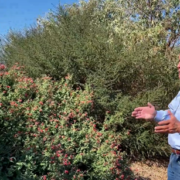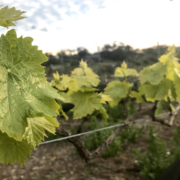Vineyard Agroforestry: Growing Grapes in the Era of Climate Change
 Print This Post
Print This Post
By Katherine Favor, Sustainable Agriculture Specialist
I had the privilege of undergoing my graduate school research in one of the best places on earth: Mendoza, Argentina. Mendoza, like many parts of California, is an arid region with very little rainfall, similar soils, and similar weather patterns. And, like California, it grows great wine. Unlike California, though, Mendoza still has many vineyards that are intercropped with trees in vineyard agroforestry systems. That’s why, when I decided to study arid vineyard agroforestry systems for my master’s research, Mendoza is where I journeyed to.

Taking petiole samples in a vineyard agroforestry system in Mendoza, Argentina, to study whether or not trees in vineyards influence grapevine nutrition. Photo: Katherine Favor
Vineyard agroforestry systems used to be common throughout the world. Vitis vinifera, is, in fact, a vine, and what did vines grow on before trellis systems were invented? Trees, of course! Vines and trees fit together evolutionarily, and vineyard agroforestry systems were common in wine grape growing regions all over the world up until just a few hundred years ago. Whether it was vines climbing up trees, a few trees interspersed throughout vineyards, or trees being intercropped with olives, stone fruit, and oaks, vineyard agroforestry systems are as old as wine itself.
Nowadays, of course, the majority of vineyards are monocultures. If you even mention planting trees near vines, viticulturists tend to freak out. “No way, the trees will shade my vines! Are you crazy?” I know this because I was once a viticulturist who said just that.
And then, climate change came. In the summer of 2018, the heat got so bad in Southern California that grape growers in Temecula watched their fruit shrivel on the vine and even abort, in some cases. No amount of water they put on could save the grapes once that heat hit. The clusters that did survive were so baked by the sun that they became irreparably jammy and far too sweet to create balanced wines. This, combined with the degradation of acids and anthocyanins that came with the high heat, caused their high-quality price point to instantly plummet. It got so bad that folks started thinking about constructing giant shade structures over their vineyards to protect their vines from the sun. I started thinking about vineyard agroforestry. Could trees provide that shade to vines, instead of shade cloth?
Then, the following winter, it got so hot that our vines broke bud in late January, months before we were expecting them to. Next thing you know, a frost hit, and of course it killed some of our buds. Being in San Diego, our frost was mild and our vines weren’t hit too hard. But growers in other parts of the world are increasingly reporting this same issue, with much more serious consequences. Vineyards in France have reported losing entire crops to climate-change-induced early bud break and the resulting frost damage. As a result, they are resorting to lighting fires in their vineyards at night, flying helicopters over their fields to invert heat in the air onto their vines, or just mourning their losses. Others, however, are planting trees. Trees in vineyards have been shown to protect vines from frost due to their nighttime radiative heating effects. Could trees be the climate change solution we’re needing, for both heat damage and frost damage?

Olive trees intercropped with Cabernet Sauvignon grapevines in Maipu, Mendoza, Argentina. Photo: Katherine Favor
Let’s face it, climate change is here. And we grape growers have to do something about it if our grapes are going to survive. Agroforestry is one approach among many that can help wine grape growers not only adapt to the harmful effects of climate change, but also mitigate it. If done right, vineyard agroforestry systems can protect vines from both extreme heat and extreme cold, while simultaneously providing numerous other ecosystem benefits to vineyards, such as improved IPM control, increased whole-farm yield, increased soil water-holding capacity, reduced erosion, cleaner watersheds, and increased global carbon sequestration. However, it has to be done right in order for it to work. Trees compete with grapes for nutrients, water, and light, and this competition has to be planned for and managed meticulously if your system is going to function well.
There is still SO much that we don’t know about vineyard agroforestry systems. Science is just now beginning to get a good picture of both the competitive and synergistic interactions that occur in these systems. But many studies have been done, and here’s what we do know:
Drawbacks:
- Vineyard agroforestry systems are inherently more intensive to manage than are monocultures.
- Managing two crops within one system requires expertise in two areas and equipment for two crops.
- Incorporating trees into vineyards results in yield reduction in vines within 4 meters of tree hedgerows.
- Vines and trees do not appear to compete significantly for nutrients or water, but may compete for light.
- Trees in general consume a lot of water, and care must be taken to select drought-tolerant species, and to space them at proper distances for reduced water consumption.
- The presence of trees can increase bird predation in vines, so proper infrastructure must be in place to deal with damage from birds.
Benefits:
- Vineyard agroforestry systems significantly increase beneficial insects in vineyards and have been shown to significantly reduce farmer reliance on chemical pesticides.
- Trees in vineyards create a “microclimatic bubble” that has been shown to protect vines both from frost and extreme heat.
- Trees improve soil water holding capacity, potentially leading to long-term drought resistant soil.
- Trees improve soil fertility and prevent erosion losses.
- Vineyard agroforestry systems have been shown to improve certain wine quality indicators such as brix, density, and total acidity.
- Trees planted in hedgerow or alley cropping orientations in vineyards protect vines from wind and significantly reduce wind erosion.
- Vineyard agroforestry systems provide numerous ecosystem benefits such as increased habitat for biodiversity, carbon dioxide sequestration, and improved watershed health.
- Despite yield reductions within 4 meters of trees, there is the potential for whole-farm income to be increased when the correct vine-tree combination is selected, and trees may prevent enough yield losses so that the reduced yield is balanced out.

Olive trees intercropped with Malbec grapevines in Mendoza, Argentina. Photo: Katherine Favor
Climate change is hurdling towards us faster than the science around vineyard agroforestry systems can keep up with. There’s a lot that we don’t know about these systems, but there’s enough that we do know to indicate that vineyard agroforestry systems might be worth trying out, especially in arid growing regions that are impacted by significant heat stress, such as Southern California. Agroforestry is no silver-bullet solution, and it doesn’t come without tradeoffs. Vineyard agroforestry systems (as with all agroforestry systems) require planning and management strategies in order to maximize the synergistic reactions between trees and vines and in order to minimize the competitive ones. But, when these interactions are managed well, planting trees in vineyards could help vineyards become more climate resilient, while providing numerous other ecosystem services.
If you’re thinking of trying vineyard agroforestry out, let us know! ATTRA has lots of resources to help you get there. Good luck, and may the forest be with you!
Related Resources:
Favor, Katherine. 2021. Chapter 4: Below-Ground Services in Vineyard Agroforestry Systems. In: Udawatta R, Jose S (eds) Agroforestry and Ecosystem Services. Springer International Publishing.
This blog is produced by the National Center for Appropriate Technology through the ATTRA Sustainable Agriculture program, under a cooperative agreement with USDA Rural Development. ATTRA.NCAT.ORG.

